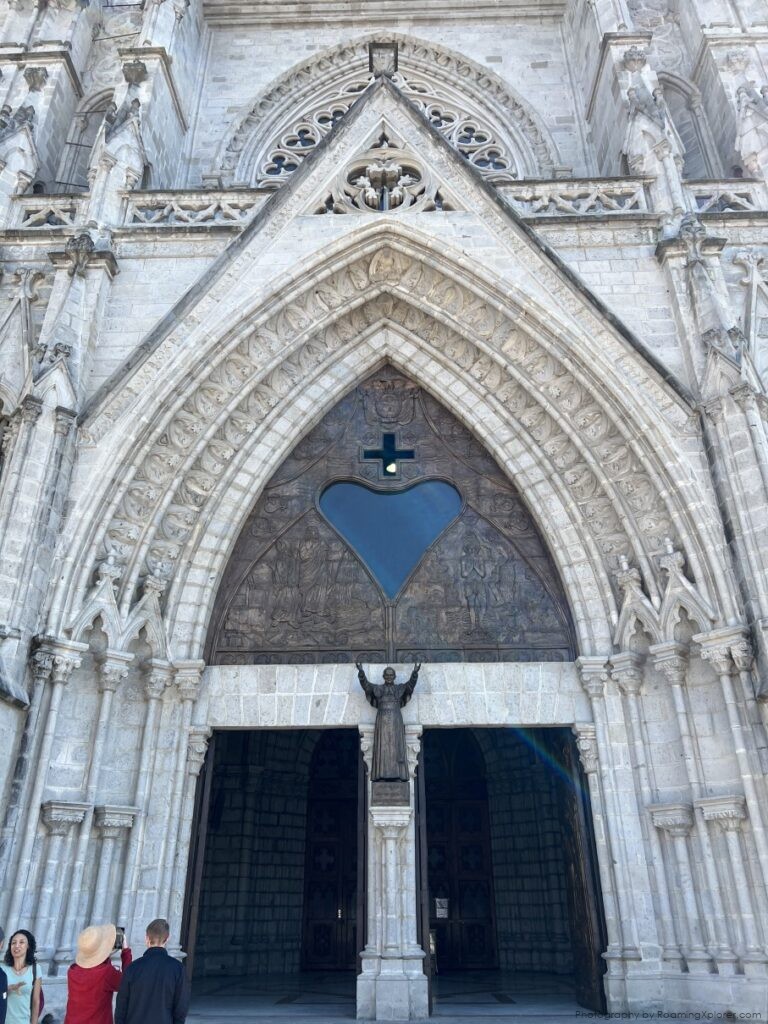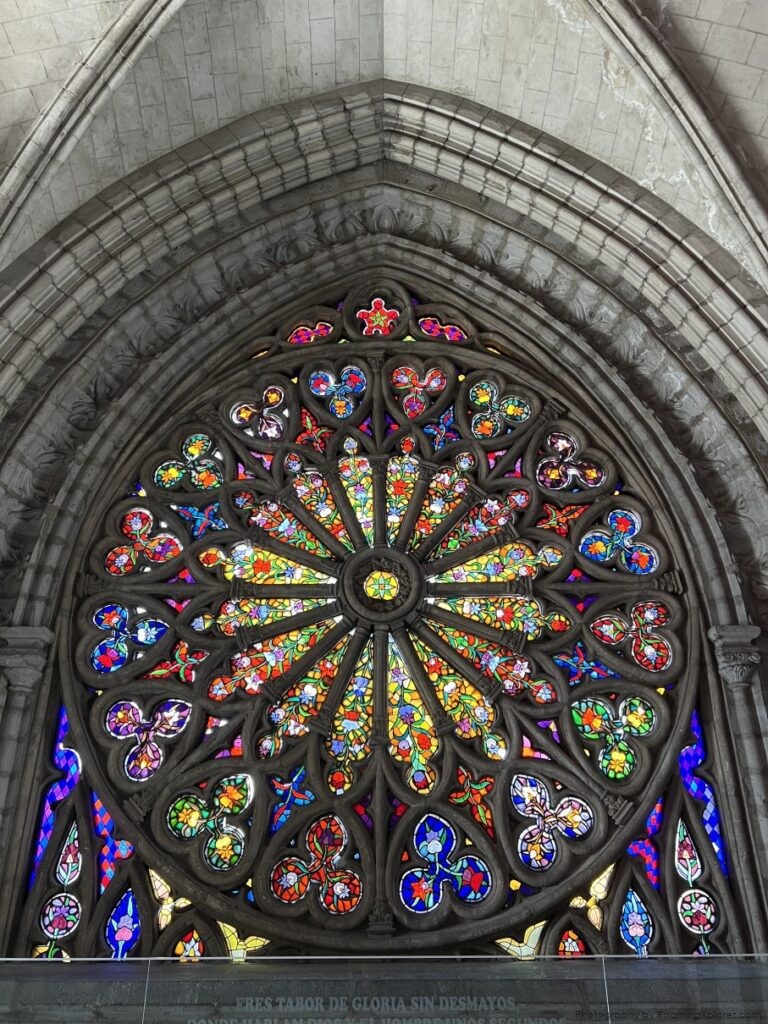Quito’s Basilica del Voto Nacional towers over the city, offering a glimpse into Ecuador’s history, devotion, and breathtaking architecture. My visit there was not only a journey through a monumental piece of Gothic Revival architecture but also a reflection on how faith and history intertwine in this vibrant capital.
A Towering Marvel in Quito
The first sight of the Basilica del Voto Nacional is unforgettable. Perched on the slopes of El Panecillo Hill, its twin towers pierce the sky, drawing attention from nearly every corner of Quito. I was captivated by its imposing yet intricate façade, standing tall as the largest neo-Gothic Basilica in the Americas.






Approaching the basilica, I could already feel the weight of its history. Its sheer size—larger than I imagined—reminded me of the great European cathedrals I had seen, but with a unique Ecuadorian twist. This blend of old-world design with local influences is what makes this place so special.
The gargoyles on the basilica are perhaps its most fascinating and unusual feature. Instead of the typical gargoyles seen in European churches, the ones at the Basilica del Voto Nacional depict animals native to Ecuador—turtles, iguanas, armadillos, and more. I spent several minutes just admiring the details of these creatures that symbolize the country’s rich biodiversity. They lend the basilica a personality all its own, a reminder that this structure is as much Ecuadorian as it is Gothic.
A Journey Through Time
The basilica’s history is as rich and complex as the city it calls home. It was built as a symbol of the vow (voto) made by Ecuador to the Sacred Heart of Jesus, promising the construction of a monumental church in return for divine protection. Construction began in 1892, and while the basilica is still technically unfinished—a local legend claims that completing it would bring about the end of the world—it was consecrated in 1988, nearly a century later.
Walking through its grand entrance, I was struck by how new the basilica felt, despite its Gothic design. This is a relatively young building compared to some of the ancient churches I’ve visited, yet it carries an air of timelessness, as though it has been watching over Quito for centuries. I couldn’t help but think of how faith endures, transcending time and trends.
Inside, the soaring ceilings, tall stained-glass windows, and massive stone pillars echoed the grandeur of Gothic cathedrals. The colored light streaming through the windows painted the interior in a kaleidoscope of hues. I found myself pausing at each window, mesmerized by the delicate designs, many of which depict scenes from the Bible and Ecuador’s religious history. The serenity inside was a sharp contrast to the bustling city streets outside. It felt like a sanctuary, not only from the noise of the city but from the rapid pace of modern life.
Climbing to the Heights
One of the highlights of my visit to the basilica was the chance to climb its towers. This is not for the faint-hearted, but the reward is more than worth the effort. As I ascended the winding staircases and narrow passageways, the city of Quito gradually unfolded beneath me. Each step brought me closer to a panoramic view that, once reached, took my breath away.



From the top of the towers, Quito looked like a patchwork quilt of history and modernity, with colonial buildings and modern skyscrapers coexisting within the city’s Andean valley. The view of El Panecillo Hill, with the statue of the Virgin of Quito standing proudly on its summit, was especially striking from this vantage point. It’s one of those moments where you feel connected to both the past and present of a city.
I took a moment to catch my breath and absorb the scene. The Andes mountains loom in the background, reminding you that Quito is not just any city—it’s a city in the sky, nestled high in the mountains. The basilica, with its towering spires, is a perfect symbol of Quito’s aspirations, both spiritual and physical.
A Sacred Heart in the Andes
The basilica’s connection to the Sacred Heart of Jesus is one of its most profound aspects. As I stood in front of the massive statue of the Sacred Heart inside the basilica, I was reminded of the spiritual significance that the basilica holds for the people of Ecuador. It represents not just a place of worship, but a promise—one that has been passed down through generations. The faith that built this structure is the same faith that sustains it today.
As I wandered through the basilica, I noticed small groups of local worshippers sitting in quiet prayer. Despite its grandeur, the basilica is still very much a living church, a place where people come to seek solace and guidance. The sense of devotion in the air was palpable, a reminder that while the basilica may be an architectural marvel, its true purpose is spiritual.
Ecuador’s Symbol of Faith and Unity
The Basilica del Voto Nacional is not just an extraordinary building; it’s a symbol of Ecuadorian identity. Its construction was a national project, meant to unify the country through a shared expression of faith. Even today, the basilica stands as a reminder of that unity. Ecuador’s history, like its landscape, is full of contrasts—indigenous and colonial, ancient and modern—and the basilica embodies that blend.



Its location in the historic center of Quito, a UNESCO World Heritage Site, places it at the heart of Ecuador’s cultural and historical identity. I couldn’t help but think about the basilica’s role in connecting Ecuador’s past with its present. From the indigenous communities that lived in these lands long before the Spanish arrived, to the colonial era that shaped much of the city’s architecture, and finally, to modern Quito with its bustling streets and growing skyline—the basilica is a testament to the endurance of faith through it all.
Reflecting on My Visit
Leaving the basilica, I felt both awe and peace. Awe at the sheer scale and beauty of the building, and peace from the sense of tranquility it offers in the midst of a busy city. My visit to the Basilica del Voto Nacional was more than just a chance to see another historic building—it was a reminder of the deep ties between faith, history, and identity.
In many ways, the basilica mirrors Quito itself: a city of contrasts, where tradition and modernity sit side by side, and where history is very much alive in the present. The Basilica del Voto Nacional is a place where the past and future meet, and it’s a must-see for anyone who wants to understand the soul of Quito.
Whether you’re climbing its towers for a panoramic view of the city or sitting quietly in one of its pews, the basilica offers a unique experience—one that invites you to look both inward and outward, to reflect on your own journey as you stand in the shadow of something much greater.
Final Thoughts
Visiting the Basilica del Voto Nacional left a lasting impression on me. Its grandeur, symbolism, and location at the heart of Quito make it a remarkable site, not just for its architectural beauty but for what it represents—a fusion of Ecuador’s history, faith, and cultural identity. Climbing its towers and witnessing the panoramic views gave me a new perspective on Quito, while the quiet moments inside its walls reminded me of the enduring power of faith.
If you ever find yourself in Quito, don’t miss the chance to visit this stunning landmark. Whether you’re a history enthusiast, a lover of architecture, or simply seeking a moment of reflection, the Basilica del Voto Nacional is a place that speaks to the heart and soul of Ecuador.
More Information Wikipedia
![]()

